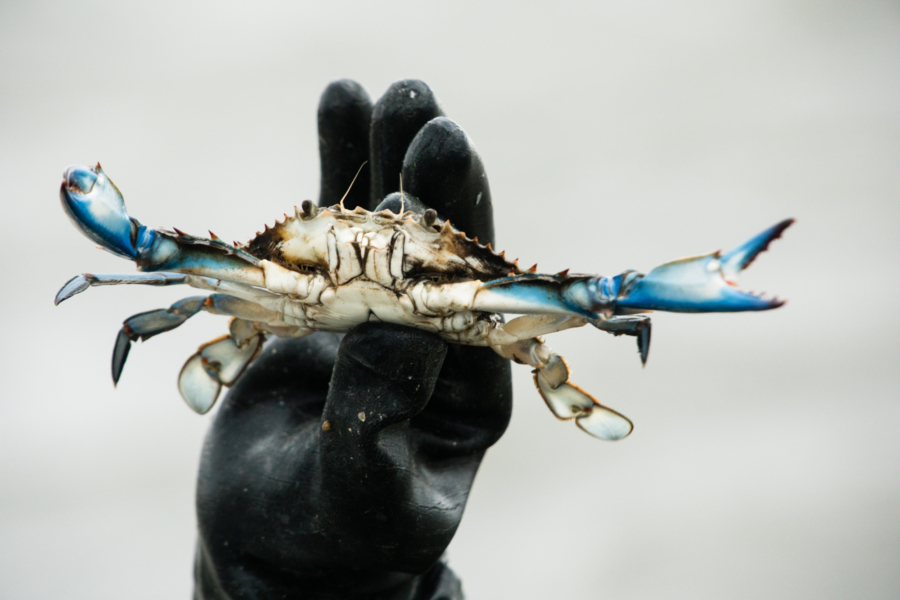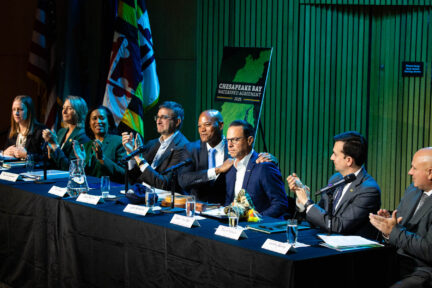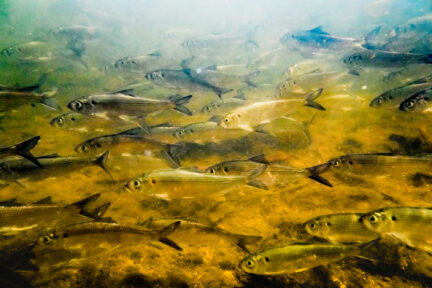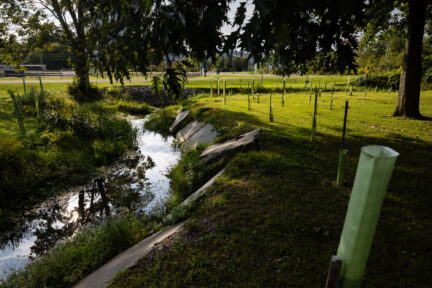Annual Blue Crab Advisory Report Finds Lower Blue Crab Population, but No Overfishing
Scientists plan to take a deeper dive into understanding population dynamics for upcoming blue crab stock assessment

Annapolis, Maryland—Analysis by the Chesapeake Bay Stock Assessment Committee (Committee) indicates that the Bay’s blue crab population is not overfished based on current biological reference points. But the recently released 2025 Blue Crab Advisory Report also notes that adult and juvenile numbers are near their lowest levels in recent years.
The Committee recommends that the jurisdictions that manage fishing for blue crabs in the Chesapeake Bay continue to conserve female and juvenile crabs to ensure a healthy future for the population—and to maintain measures to protect males as well.
The annual Blue Crab Advisory Report includes analysis of data from the 2024–25 Winter Dredge Survey, which estimates the blue crab population in the Bay through comprehensive surveys. This data helps scientists and resource managers understand how healthy the population is, and what percentage of the population has been harvested. The Winter Dredge Survey is conducted annually by Maryland and Virginia.
The Winter Dredge Survey estimated:
- The overall blue crab population in early 2025 was 238 million. This is down from last year’s 317 million, marking the second-lowest population since the Winter Dredge Survey began in 1990.
- There were 103 million juvenile blue crabs in 2025, a drop from last year’s 138 million and the third-lowest population since 1990. (The lowest and second-lowest populations were observed in 2021, and 2022, respectively.
- The female population was 108 million, a decline from the 133 million in 2024.
- The male population was 26 million, down from 2024’s 46 million and the lowest estimate since 1990.
Scientists closely track the number of female blue crabs because they are key to the future of the population. While the female numbers are down, they are still above the “threshold” number of 72.5 million—the minimum acceptable level—but they are below the “target” number of 196 million.
Scientists Exploring Why the Population Is Lower
The Blue Crab Advisory Report also considers harvest data from 2024. To help protect the future of the population, resource managers set guardrails on the harvest of female blue crabs. Bay-wide, managers currently target a harvest of 28% of female crabs in a given year, with an upper limit of 37%. But in 2024, 22%—below even the target—was harvested. Overall, the blue crab harvest in 2024 was 42.5 million pounds—down from the longer-term average of 59 million pounds.
The Committee has stated that conservation measures should be considered if the male harvest rate exceeds 34%. In 2024, the male harvest rate was 30%—close to, but not over, that number.
The Blue Crab Advisory Report does not identify overharvesting as the reason the blue crab population dropped in 2025.
The Winter Dredge Survey also explores how many blue crabs die each winter due to cold water temperatures and low salinity. In 2025, the overwintering mortality was 4%, higher than in recent years, but still below the 1996–2025 average of 5.98%.
Researchers continue to investigate the reasons behind low abundance and recruitment, including habitat availability (marshes, underwater grasses), predation (red drum, blue catfish), environmental conditions (water temperature, salinity, hypoxia) and oceanic conditions (wind, tidal currents).
“This year’s survey results are one piece of a broader conversation,” said Jamie Green, commissioner of the Virginia Marine Resources Commission. “Our adaptive management approach is designed to account for natural variability in the population, ensuring that we don’t overreact to short-term fluctuations. Virginia remains committed to tracking outcomes over time and working closely with our partners across the region. Sound management depends on patience, collaboration and a clear-eyed view of the data, principles we will continue to uphold to support both the resource and the livelihoods that depend on it.”
Blue Crab Stock Assessment to Reevaluate Reference Numbers
The blue crab population varies naturally from year-to-year. But while population numbers in 2025 and recent years have been in acceptable ranges, scientists and resource managers note that they have fallen toward the lower end of that range.
To explore whether the reference points used to determine whether the population is healthy need to be updated, scientists are developing an updated benchmark stock assessment. This report will be a much deeper dive into the dynamics of the blue crab population and will help resource managers evaluate whether reference points may need to be adjusted. The assessment is expected to be completed in early 2026. The most recent benchmark stock assessment was released in 2011.
“We are looking forward to seeing the results of the current blue crab benchmark stock assessment to see if it can provide insight into the changing dynamics in the Bay, given that overharvest does not appear to be the primary reason for the continued low abundances documented in recent dredge surveys,” said Mandy Bromilow, blue crab program manager, Maryland Department of Natural Resources.
The Future of Blue Crab Abundance and Management in the Chesapeake Bay Watershed Agreement
Chesapeake Bay Program partners, through the Sustainable Fisheries Goal Implementation Team and the Chesapeake Bay Stock Assessment Committee, have been working toward two key outcomes in the 2014 Chesapeake Bay Watershed Agreement:
- Blue Crab Abundance: Maintain a sustainable blue crab population based on a target of 196 million adult females. Refine population targets through 2025 based on the best available science.
- Blue Crab Management: Manage for a stable and productive crab fishery including working with industry, recreational crabbers and other stakeholders to improve commercial and recreational harvest accountability.
Chesapeake Bay Program partners are working to update and revise the Watershed Agreement to guide efforts beyond 2025. The health of the blue crab population is a vital part of the Chesapeake Bay and the economy it supports, and a revised blue crab outcome is proposed for the updated Chesapeake Bay Watershed Agreement because continued work to advance the science related to management of the blue crab fishery is needed to ensure its sustainability.
“We remain committed to supporting science-based approaches to maintain a healthy blue crab population. As partners revise the Watershed Agreement beyond 2025, the focus will remain on collaborative efforts that support a stable crab fishery while balancing ecological health and the needs of those who depend on it,” said Ronald Owens, executive secretary, Potomac River Fisheries Commission.
Revisions to the blue crab outcomes will be available for public feedback beginning July 1, 2025. The most up-to-date information on the Beyond 2025 effort can be found at https://www.chesapeakebay.net/what/what-guides-us/planning-for-2025-and-beyond.



